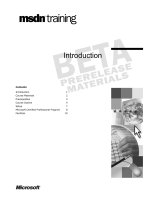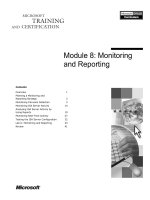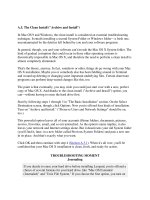Diffraction, Non-Crystallinity, and the PDF Database pdf
Bạn đang xem bản rút gọn của tài liệu. Xem và tải ngay bản đầy đủ của tài liệu tại đây (3.28 MB, 26 trang )
Diffraction, Non-Crystallinity, and
the PDF Database
Cyrus E. Crowder, ICDD
Tim Fawcett, ICDD
Classical Diffraction
• Classic ‘Bragg’ scattering is characterized by discrete
peaks arising from long-range crystallographically
ordered planes:
λ = 2d
hkl
sinθ
hkl
• The 2009 PDF databases have > 660,000 entries based
on the concept of discrete Bragg peaks arising from
crystalline structures.
• The existing concept of ‘Phase Identification’ is based on
matching accurately-determined positions and intensities
of peaks in an experimental patterns to those for PDF
database entries.
Classical XRPD
NaCl – An Example
1 1 1 2 0 0 2 2 0
2 2 2
3 1 1
The XRPD Pattern of a Common
Pharmaceutical Excipient
The process of identifying this material by conventional XRPD search/match
techniques is compromised by the small number of clearly defined diffraction
maxima and the difficulty in specifying the precise positions of these maxima.
Further, these ‘maxima’ are likely shifted from the true underlying positions of the
major Bragg peaks due to the significant overlap.
Use of full pattern matching for phase
identification
• The ICDD has begun compiling a database (PD3) of
XRPD profiles for such materials.
• Such a database can be used for manual comparison
with an experimental pattern, however manual
comparisons with larger databases for identifying true
unknown materials would be slow and subjective.
• An automated full-pattern comparison would be
desirable to screen the database for most-likely
matches.
The Integral Index
• The Integral Index is a numerical value based on a point-by-
point comparison of two digitized X-ray diffraction pattern This
numerical value ranges from 0-100 and is based on the
Hofmann and Kuleshova similarity index [1]:
• The lower the index value, the better the match, giving 0 a
perfect match and 100 a complete non-match.
• We can use this relationship to rank the match between full
patterns from a given database set with the pattern from the
unknown material
∑
∑
∑
∑
∑
=
=
=
=
=
⎥
⎥
⎥
⎥
⎦
⎤
⎢
⎢
⎢
⎢
⎣
⎡
−=
n
i
n
j
count
i
i
count
n
j
calc
i
i
calc
jI
iI
jI
iI
n
S
1
1
1
1
1
int
0
00
1
Example Using Integral Index to
Identify Nanocrystalline Material
• To facilitate comparison, the
background is removed before
computing the integral indices.
• To facilitate speed, the
database is limited to a likely
subset of entries, in this case
anything with cellulose in the
name.
• If unsuccessful, other subfiles,
i.e., polymers, fillers, or
forensics, could be specified.
Perform Integral Index Calculations
• An estimated crystallite size parameter
is used to compute comparible FWHMs
for peaks, in this case, 3.5 nm.
• The software simulates a pattern for
each database entry, using the d-space
and intensity values.
• Each simulated database pattern is
compared with the unknown pattern to
generate integral index values.
Patterns Generated from Crystal Structure
Where Available
References for Form I alpha,
Form I beta and Form II
Simulation of microcrystalline
states of cellulose
Via PDF-4+
Scardi, Leoni
Faber
PDF 00-056-1717 Cell II
PDF 00-056-1718 Cell I beta
PDF 00-056-1719 Cell I alpha
Patterns Generated from Experimental d-I list if
Crystal Structure is Not Available
Use of Integral Index
Integral Index = 2.26
Cellulose 1β
Comparing with all 16 PDF
experimental entries that
contain ‘cellulose’ in the name,
the integral index values vary
from 2.26 up to 19.28 for these
entries.
The best integral index fit is
with 50-2241 – cellulose Iβ.
Comparison of Simulated Cellulose
Patterns to Experimental Pattern
Cellulose Iβ
Integral Index = 2.26
Cellulose II
Integral Index = 5.93
Red – experimental pattern
Blue – ‘Standard’ database pattern
Clearly, the cellulose 1β polymorph
is a better match than the cellulose II
polymorph.
Non-crystalline Material
This is an X-ray ‘diffraction’ pattern for amorphous cellulose (Sigma Cellulose ground 13
hours). The same pattern is obtained after long periods of grinding, regardless of whether
the starting cellulose was form Iα, Iβ, or II. (Courtesy Ewa Bucher, International Paper)
The lack of long range order means we have no conventional “Bragg” diffraction, but
instead, rather broad features based on the distribution of interatomic distances within the
disordered structure.
Nanocrystalline Cellulose Iα?
Comparison of X-ray diffraction patterns for amorphous cellulose and that for
the cellulose Iα crystalline form with a simulated crystallite size of 1.5 nm.
Nanocrystalline Cellulose Iβ?
Comparison of X-ray diffraction patterns for amorphous cellulose and that for
the cellulose Iβ crystalline form with a simulated crystallite size of 1.5 nm.
Nanocrystalline Cellulose II?
Comparison of X-ray diffraction patterns for amorphous cellulose and that for
the cellulose II crystalline form with a simulated crystallite size of 1.5 nm.
Amorphous Standards
• Clearlythedatabaseshouldbeexpandedtoincludefull
patternsforstandardamorphousmaterialssincethese
cannotbegeneratedfromBraggpeakpositionsor
crystallographicinformation.
• Thiswouldallowintegralindexcomparisonstobe
performedforbothamorphousstandardsaswellas
nanocrystallinevariationsofcrystallinematerials
alreadyinthedatabase.
Raw Polymer Pattern for Identification
using Integral Index
Background
Removal
Integral Index Calculations for
Polymer Pattern
PDF-4+ 2009 database searched for entries containing ‘poly’ in the
name and having elements only within the set of C, H, N, O, F, and
Cl. Found: 651
Using a crystallite size of ~15 nm, Integral Index values were
computed for this experimental pattern that ranged from ~2.5 to 45.
(Roughly 20 seconds to compute on a 2-year-old Dell Inspiron.)
The top three are examined closer on the next slide.
Integral Index Results for Polymer
Semi-crystalline Polypropylene
Crystalline Polypropylene
Semi-crystalline Polypropylene
Polymers such as these are really 2-
phase systems, one being crystalline,
the other being amorphous.
Unlike polypropylene, many have only
one or two significant Bragg peaks
making conventional search/match
identification difficult.
Automated full pattern comparisons
have the potential to be a better
identification tool for XRPD patterns of
many polymers.
Disordered Structures
Faulted clay materials
The Editorial Challenge of a “Full
Pattern” Database
• How many ‘different’ entries are needed for
a given material (i.e. chain branching,
molecular weight, melting point, degree of
crystallinity, etc)?
St. Johns Wort
Echinacea Lipoic Acid
Powdered Bone
Benadryl
Nanomaterials
and blends
Effexor
Cough Drop
Saw Palmetto
3 Sources
Cellulose*
*Courtesy of Ewa Bucher
International Paper
SunTheanine
Amorphous Materials and Blends









